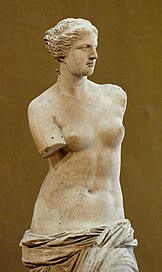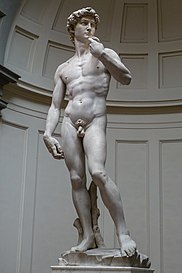
Back جاذبية جسدية Arabic Skønhedsideal Danish Attraktivität German Atractivo físico Spanish جذابیت جسمانی Persian Attirance physique French शारीरिक आकर्षण Hindi Ֆիզիկական գրավչություն Armenian Daya tarik fisik ID Attrattività fisica Italian


Physical attractiveness is the degree to which a person's physical features are considered aesthetically pleasing or beautiful. The term often implies sexual attractiveness or desirability, but can also be distinct from either. There are many factors which influence one person's attraction to another, with physical aspects being one of them. Physical attraction itself includes universal perceptions common to all human cultures such as facial symmetry,[9] sociocultural dependent attributes, and personal preferences unique to a particular individual.[10]
In many cases, humans subconsciously attribute positive characteristics, such as intelligence and honesty, to physically attractive people, a psychological phenomenon called the Halo effect.[11] Research done in the United States and United Kingdom found that objective[12] measures of physical attractiveness and intelligence are positively correlated, and that the association between the two attributes is stronger among men than among women.[13] Evolutionary psychologists have tried to answer why individuals who are more physically attractive should also, on average, be more intelligent, and have put forward the notion that both general intelligence and physical attractiveness may be indicators of underlying genetic fitness.[13] A person's physical characteristics can signal cues to fertility and health,[14][15][16] with statistical modeling studies showing that the facial shape variables that reflect aspects of physiological health, including body fat and blood pressure, also influence observers' perceptions of health.[17] Attending to these factors increases reproductive success, furthering the representation of one's genes in the population.[18]
Heterosexual men tend to be attracted to women who have a youthful appearance and exhibit features such as a symmetrical face,[19] full breasts, full lips, and a low waist–hip ratio.[20][21] Heterosexual women tend to be attracted to men who are taller than them and who display a high degree of facial symmetry, masculine facial dimorphism, upper body strength, broad shoulders, a relatively narrow waist, and a V-shaped torso.[22][23][24][25]
- ^ "People: Just Deserts". Time. May 28, 1945. Archived from the original on August 11, 2009. Retrieved August 5, 2011.
... "the most perfect all-over beauty of all time." Runner-up: the Venus de Milo.
- ^ "Says Venus de Milo was not a Flapper; Osteopath Says She Was Neurasthenic, as Her Stomach Was Not in Proper Place" (PDF). The New York Times. April 29, 1922. Retrieved August 5, 2011.
Venus de Milo ... That lady of renowned beauty...
- ^ CBS News Staff (August 5, 2011). "Venus". CBS News. Archived from the original on January 29, 2010. Retrieved August 5, 2011.
The classical vision of beauty exemplified in Greek art, such as the 2nd century B.C. Venus de Milo (a.k.a. Aphrodite of Milos), was an ideal carried through millennia, laying the basis for much of Western art's depictions of the human form.
- ^ Kousser R (2005). "Creating the Past: The Vénus de Milo and the Hellenistic Reception of Classical Greece". American Journal of Archaeology. 109 (2): 227–50. doi:10.3764/aja.109.2.227. ISSN 0002-9114. S2CID 36871977.
- ^ Wilkinson P (1998). Illustrated Dictionary of Mythology. DK Pub. ISBN 9780789434135.
- ^ Day J (2004). "Does the Old Testament Refer to Sacred Prostitution and Did It Actual Exist in Ancient Israel?". In McCarthy C, Healey JF (eds.). Biblical and Near Eastern Essays: Studies in Honour of Kevin J. Cathcart. Cromwell Press. pp. 2–21. ISBN 978-0-8264-6690-7.
- ^ Singh NK (1997). Divine Prostitution. New Delhi: APH Publishing. pp. 4–6. ISBN 978-81-7024-821-7.
- ^ Perkins D (2013). Encyclopedia of China: History and Culture. Routledge. p. 581. ISBN 978-1135935627.
- ^ Grammer K, Thornhill R (October 1994). "Human (Homo sapiens) facial attractiveness and sexual selection: the role of symmetry and averageness". Journal of Comparative Psychology. 108 (3): 233–42. doi:10.1037/0735-7036.108.3.233. PMID 7924253. S2CID 1205083. Retrieved May 4, 2019.
- ^ Zeigler-Hill V, L M Welling L, Shackelford TK (2015). Evolutionary Perspectives on Social Psychology. United States: Springer Science+Business Media. p. 329. ISBN 978-3-319-12697-5.
...why, despite broad agreement, we see a wide variety of personal preferences.
- ^ Dion, Berscheid & Walster (1972).
- ^ Simpson, Jeffry A (1990). "Perception of physical attractiveness: Mechanisms involved in the maintenance of romantic relationships". Journal of Personality and Social Psychology. 6 (59): 1192–1201. doi:10.1037/0022-3514.59.6.1192. Retrieved November 19, 2022.
- ^ a b Kanazawa S (2011). "Intelligence and physical attractiveness". Intelligence. 39 (1): 7–14. doi:10.1016/j.intell.2010.11.003.
- ^ Stephen ID, Tan KW (2015). "Healthy body, healthy face? Evolutionary approaches to health perception.". In Sheppard E, Haque S (eds.). Culture and Cognition: A Collection of Critical Essays. Peter Lang International Publishers.
- ^ Brown WM, Price ME, Kang J, Pound N, Zhao Y, Yu H (September 2008). "Fluctuating asymmetry and preferences for sex-typical bodily characteristics". Proceedings of the National Academy of Sciences of the United States of America. 105 (35): 12938–43. Bibcode:2008PNAS..10512938B. doi:10.1073/pnas.0710420105. PMC 2529114. PMID 18711125.
- ^ Bulczak, Grzegorz; Gugushvili, Alexi (March 17, 2023). "Physical attractiveness and cardiometabolic risk". American Journal of Human Biology. 35 (8): e23895. doi:10.1002/ajhb.23895. hdl:10852/109227. ISSN 1042-0533. PMID 36932650. S2CID 257604055.
- ^ Stephen ID, Hiew V, Coetzee V, Tiddeman BP, Perrett DI (2017). "Facial Shape Analysis Identifies Valid Cues to Aspects of Physiological Health in Caucasian, Asian, and African Populations". Frontiers in Psychology. 8: 1883. doi:10.3389/fpsyg.2017.01883. PMC 5670498. PMID 29163270.
- ^ Barelds-Dijkstra & Barelds (2008).
- ^ Cite error: The named reference
Briscoe-2004was invoked but never defined (see the help page). - ^ Fisher, Maryanne L. (2017). The Oxford Handbook of Women and Competition. Oxford University Press. p. 603. ISBN 978-0-19-937639-1.
- ^ Nettle D (September 2002). "Women's height, reproductive success and the evolution of sexual dimorphism in modern humans" (PDF). Proceedings. Biological Sciences. 269 (1503): 1919–23. doi:10.1098/rspb.2002.2111. PMC 1691114. PMID 12350254.
- ^ Glassenberg et al. (2010).
- ^ Perrett et al. (1998).
- ^ Sell A, Lukazsweski AW, Townsley M (December 2017). "Cues of upper body strength account for most of the variance in men's bodily attractiveness". Proceedings. Biological Sciences. 284 (1869): 20171819. doi:10.1098/rspb.2017.1819. PMC 5745404. PMID 29237852.
- ^ Mautz BS, Wong BB, Peters RA, Jennions MD (April 2013). "Penis size interacts with body shape and height to influence male attractiveness". Proceedings of the National Academy of Sciences of the United States of America. 110 (17): 6925–30. Bibcode:2013PNAS..110.6925M. doi:10.1073/pnas.1219361110. PMC 3637716. PMID 23569234.
Cite error: There are <ref group=lower-alpha> tags or {{efn}} templates on this page, but the references will not show without a {{reflist|group=lower-alpha}} template or {{notelist}} template (see the help page).

